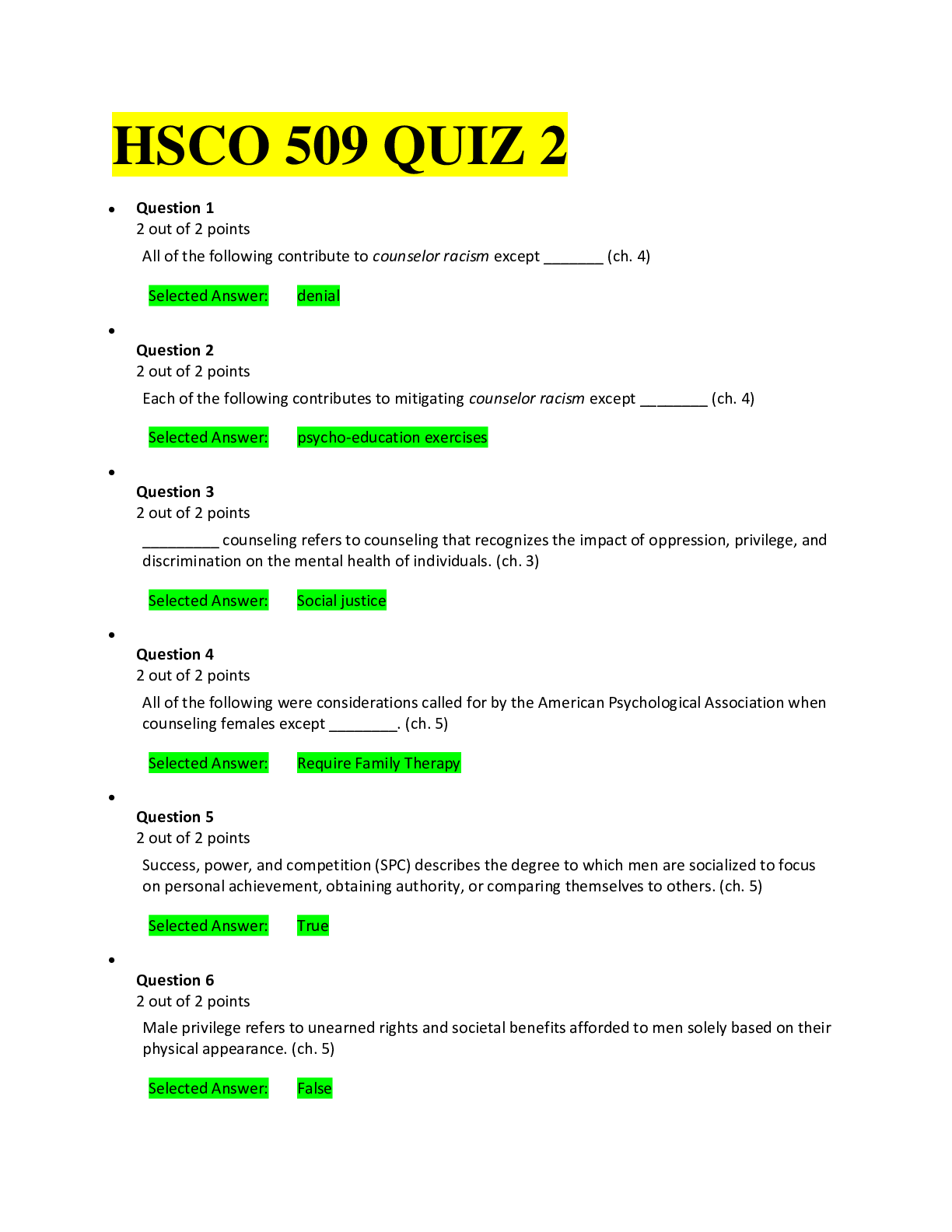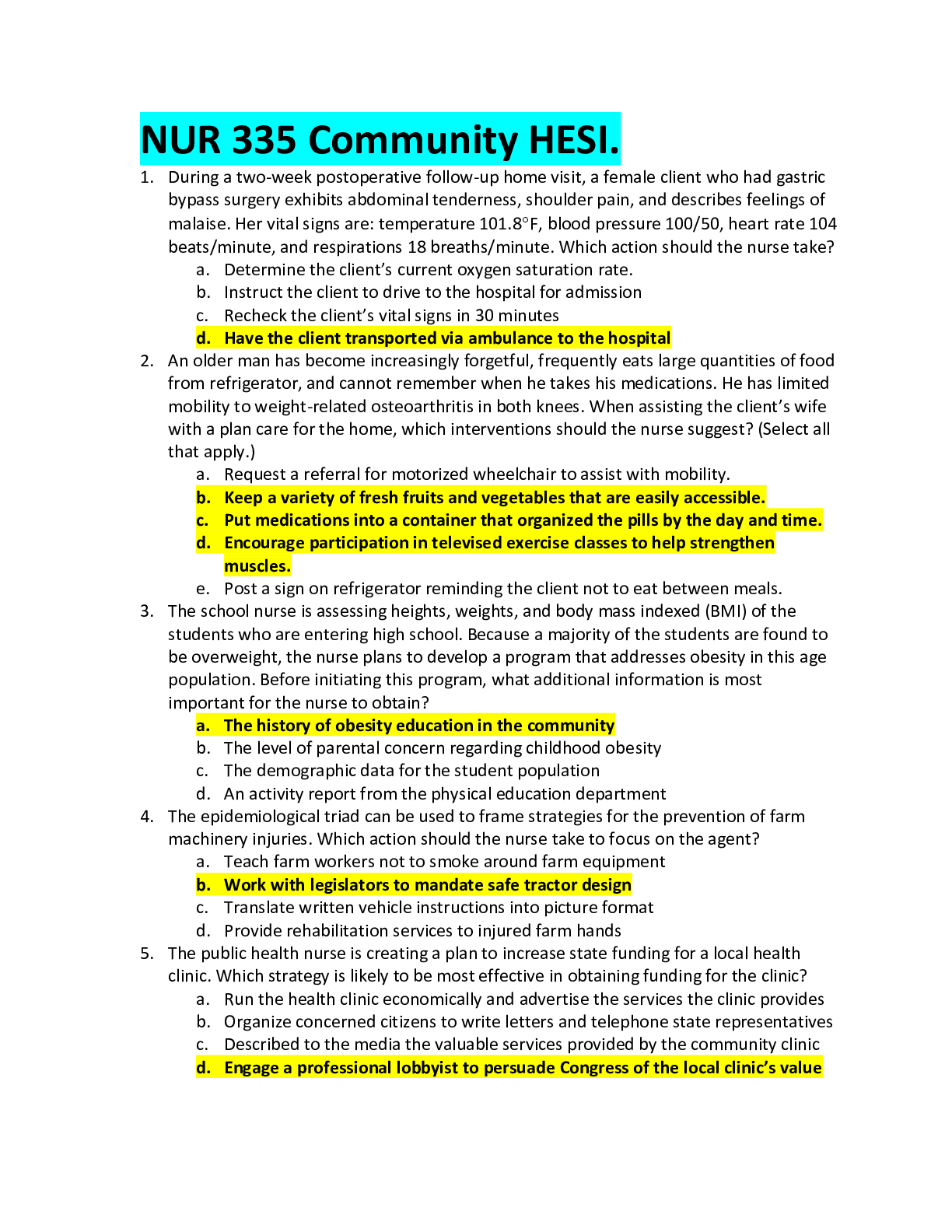Counseling > EXAM > HSCO 509 Quiz 2 ; Liberty University answers complete solutions, Latest 2019/20. (All)
HSCO 509 Quiz 2 ; Liberty University answers complete solutions, Latest 2019/20.
Document Content and Description Below
HSCO 509 QUIZ 2 • Question 1 All of the following contribute to counselor racism except _______ (ch. 4) • Question 2 Each of the following contributes to mitigating counselor ... racism except ________ (ch. 4) • Question 3 _________ counseling refers to counseling that recognizes the impact of oppression, privilege, and discrimination on the mental health of individuals. (ch. 3) • Question 4 All of the following were considerations called for by the American Psychological Association when counseling females except ________. (ch. 5) • Question 5 Success, power, and competition (SPC) describes the degree to which men are socialized to focus on personal achievement, obtaining authority, or comparing themselves to others. (ch. 5) • Question 6 Male privilege refers to unearned rights and societal benefits afforded to men solely based on their physical appearance. (ch. 5) • Question 7 The ACA (2005) Code of Ethics states that counselors have an ethical responsibility to continually educate themselves and to become culturally competent practitioners. (ch. 5) • Question 8 _______ is a term that has been used to describe people whose gender identities and expressions do not fit into societal norms of sex assignment (male, female) and the gender binary (man, woman). (ch. 5) • Question 9 The American Institute of Bisexuality identified seven variables involved in sexual orientation. Which of the following was not one of those variables? (ch. 6) • Question 10 Sexism is defined as the oppression of individuals based on ________. (ch. 5) • Question 11 All of the following are part of the Three-Tier Model of Social Advocacy except (ch. 3) • Question 12 The American Psychological Association uses the term ________ to define the prejudicial and discriminatory oppression of LGBTQI individuals. (ch. 6) • Question 13 _________ includes acts of depriving an individual or groups an object, label, experience, or living condition and hinders physical and psychological well-being. (ch. 3) • Question 14 _______ includes overt acts of oppression. (ch. 3) • Question 15 Ratts (2009) and others have suggested that including social justice or multiculturalism in counseling should be considered the _________ source. (ch. 3) • Question 16 The term affectional orientation allows the LGB or questioning client to use a broader spectrum of cognitive language to explore or accurately represent his or her experience of attraction. • Question 17 The authors equate the Defense of Marriage Act with institutional heterosexism. (ch. 6) • Question 18 ________ is a defining cultural characteristic in that individuals and groups perceive and understand each other through this socially constructed prism that will be transmitted to succeeding generations. (ch. 4) • Question 19 The code of ________ describes the social practice of boys becoming men by not getting too close to other boys due to learned restrictive emotionality and by avoiding all feminine behavior and attitudes. (ch. 5) • Question 20 ________ racism involves social forces, institutions, and ideologies that generate and reinforce inequalities among racial or ethnic groups. (ch. 4) • Question 21 Transgenerational focus involves coming to understand a male client’s resistance to counseling by examining his relationships with his immediate family and with his siblings in particular. (ch. 5). • Question 22 The myth of meritocracy is the notion that all individuals, regardless of racial makeup, can succeed if they “work hard.” (ch. 4) • Question 23 _______ is behaviors and attitudes that clients identify as beneficial in coping with stressful situations and adversity. (ch. 3) • Question 24 _______ racism or cultural racism refers to members of marginalized groups believing and accepting negative social messages about their own racial and ethnic groups. (ch. 4) • Question 25 Ronald Levant described normative male alexithymia as an inability to put feelings into words that result from a long socialization process in which boys are taught to suppress and deny their __________ (ch. 5) [Show More]
Last updated: 2 years ago
Preview 1 out of 5 pages

Buy this document to get the full access instantly
Instant Download Access after purchase
Buy NowInstant download
We Accept:

Reviews( 0 )
$8.00
Can't find what you want? Try our AI powered Search
Document information
Connected school, study & course
About the document
Uploaded On
Feb 23, 2020
Number of pages
5
Written in
Additional information
This document has been written for:
Uploaded
Feb 23, 2020
Downloads
0
Views
83


























